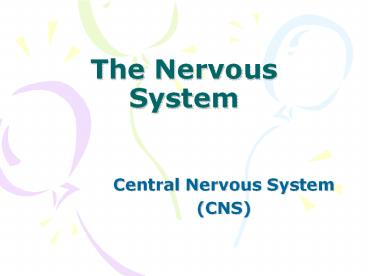The Nervous System PowerPoint PPT Presentation
1 / 42
Title: The Nervous System
1
The Nervous System
- Central Nervous System
- (CNS)
2
THE CENTRAL NERVOUS SYSTEM(BRAIN SPINAL CORD)
- The Brain
- The brain is one of the largest organs in the
body - Male brain is about 1600gm
- Female brain is about 1450gm
- (equivalent in terms of size/body wt)
3
The Brain
- The brain has 4 main areas
- Brain stem
- Diencephalon
- Cerebellum
- Cerebrum
4
The Brain Stem
5
1. The Brain Stem
- Consists of
- Medulla (Oblongata)
- connects brain and spinal cord
- contains reticular formation- responsible for
arousal and consciousness - filters out extraneous sensory
- input
6
The Brainstem
- Medulla cont.
- contains autonomic reflex centers essential for
survival - cardiac centre
- vasomotor centre
- respiratory centre
7
The Brainstem
- Pons (bridge)
- links cerebrum and medulla also brainstem
cerebellum - contains some respiratory centres
- Midbrain
- contains ascending descending tracts
- mediates auditory visual reflexes
8
2. Diencephalon
- consists of
- Thalamus
- principal relay station for sensory impulses
9
Diencephalon
- Hypothalamus
- control of homeostasis
- integration centre for Autonomic
- nervous System
- centre for emotional responses
10
Diencephalon
- Epithalamus
- contains Pineal gland - involved
- in Circadian rhythms (sleep/wake cycles)
- control of sexual functioning
11
3. Cerebellum
- Paired lobes posterior to brainstem
- Coordinates body movements, posture balance
12
4. The Cerebrum
- Enables awareness of self, sensation,
communication, memory, understanding and movement.
13
The Cerebrum
- Structure
- 2 hemispheres divided by the longitudinal fissure
- further subdivided into 5 lobes
- frontal
- parietal
- temporal
- occipital
- insula
14
The Cerebrum
- consists of
- cortex (grey matter) forms outer covering,
characterised by folds (gyri) and grooves (sulci)
- white matter internal structure
15
(No Transcript)
16
The Cerebrum
- Functionally
- sensory areas conscious perception of various
sensations - motor areas control of voluntary movements
- association areas integration of diverse
information
17
Motor Areas of cerebral cortex
- 4 AREAS (in frontal lobe)
- (1)Primary motor cortex
- control of skeletal muscles
- (2)Pre-motor cortex
- motor skill patterns
- (3)Brocas area
- speech
- (4) Frontal eye field.
- eyeball movements
18
Motor Areas of cerebral cortex
19
Cerebral Cortex
- Primary (somatic) motor cortex
- Located in the pre-central gyrus.
- Allows us to control voluntary movements of our
skeletal muscles. - The entire body is mapped in the primary motor
cortex (called a homunculus)
20
Primary Motor Cortex
21
Sensory areas of the cerebral cortex
- Several Areas
- 1)Primary somatosensory cortex (post central
gyrus) - 2)Somatosensory association area
- 3)Primary sensory and association areas for each
of the special senses - Function is conscious awareness of sensation.
22
Sensory areas of the cerebral cortex
23
Sensory areas of the cerebral cortex
- 1. Primary somatosensory cortex
- Located in the post-central gyrus.
- Receives info from somatic receptors in the skin
and proprioceptors in muscles. - Identifies body region stimulated (spatial
discrimination or localisation) - As with the primary motor cortex it is mapped.
24
Primary Somatosensory Cortex
25
Association areas
- Association areas communicate with other
association areas to analyze and recognize
sensory inputs in light of past experience.
26
Association areas
27
The Brain
- Other structures
- ventricles
- cerebrospinal fluid
- meninges
- Blood brain barrier
- cerebral blood supply Circle of Willis
28
Ventricles
- Fluid filled spaces in the brain
- Allow for production circulation of CSF
- Allow some compression
- Allow for brain growth
29
Cerebrospinal fluid (CFS)
- Watery substance originating from special
capillary networks in the ventricles (choroid
plesuses) - Rich in glucose provides nutrients
- Body produces 500ml/day.
30
Hydrocephalus
31
Meninges
- Function cover protect the CNS Blood vessels
and store (CSF). - 3 layers
- Dura mater tough outer layer (C.T)
- Arachnoid layer web like extensions- houses
major vessels - Pia Mater closely hugs the brain
32
Meninges
33
Blood Brain Barrier
- Capillary Junction in brain. Made up of
endothelial cells. Very selective re. what
substances pass through to brain.
34
Cerebral Circulation
- The Circle of Willis
- Consists of
- A specialised set of arteries that circles the
brain stem to ensure that blood flow is always
maintained - A form of inbuilt bypass (arterial anastamosis)
35
The Spinal Cord
- extends from foramen magnum to L2
- gives rise to 31 pairs of spinal nerves
- central H-shaped core of grey matter
- - surrounded by white matter
36
The Spinal Cord
- Anatomical Features
- conus medullaris
- cauda equina
- filum terminale
- cervical lumbar enlargements
- (for limb nerve supply)
- dorsal and ventral horns of grey matter
37
The Spinal Cord
38
Gray Matter Organization
- Dorsal half sensory roots.
- Ventral half motor roots.
- Dorsal and ventral roots fuse laterally to form
spinal nerves.
39
(No Transcript)
40
The Spinal Cord
- Functions
- sensory motor innervation to
- entire body below the head
- two-way communication pathway between body and
head - major reflex centre
41
- Sensory and Motor Pathways
- Sensory (ascending) pathways from periphery to
brain - Spinocerebellar proprioception
- Dorsal Column fine touch proprioception
- Spinothalamic course touch, pain, temperature
42
Sensory Motor pathways
- Motor (descending) pathways from brain to
periphery - Corticospinal (Pyramidal) skilled, conscious
movements - Extrapyramidal subconscious or coarse movements

